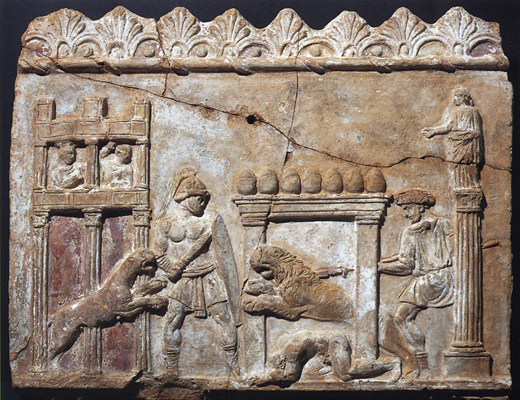

Venationes were held in the Circus Maximus almost exclusively until AD 63, when the protective moat surrounding the arena was filled in by Nero to provide additional seating for the equites. In its place, a revolving cylinder of wood, covered with ivory, was secured, which gave no foothold for the animals. Eventually, fights were transferred to the Colosseum. In this terracotta "Campana" plaque, one can see the eggs used to count laps, and a crenellated tower patterned after a wooden siege tower. The fact that the animals are shown prowling between the monuments suggests that, even by the first half of the first century AD, there still was no permanent barrier in the arena around which the chariots raced.
"At this time there occurred, too, all sorts of spectacles in honour of Severus' return, the completion of his first ten years of power, and his victories. At these spectacles sixty wild boars of Plautianus fought together at a signal, and among many other wild beasts that were slain were an elephant and a corocotta. This last animal is an Indian species, and was then introduced into Rome for the first time, so far as I am aware. It has the colour of a lioness and tiger combined, and the general appearance of those animals, as also of a dog and fox, curiously blended. The entire receptacle in the amphitheatre had been constructed so as to resemble a boat in shape, and was capable of receiving or discharging four hundred beasts at once; and then, as it suddenly fell apart, there came rushing forth bears, lionesses, panthers, lions, ostriches, wild asses, bisons (this is a kind of cattle foreign in species and appearance), so that seven hundred beasts in all, both wild and domesticated, at one and the same time were seen running about and were slaughtered. For to correspond with the duration of the festival, which lasted seven days, the number of the animals was also seven times one hundred."
Dio, Roman History (LXXVII.1.3-5)
In celebration of the seventh and final day of the Saecular Games in AD 204 (which nominally occurred once every century, saeculum, to ensure that they could be witnessed only once in a lifetime), Septimius Severus had the the spina of the Circus decorated to look like a ship. Commemorating the event, a silver denarius issued two years later shows the turning posts at the prow and stern, and a sail mounted on the obelisk in the center. Below are depicted an ostrich and bear and, between them, a lion and lioness chasing a wild ass, and a panther attacking a bison (BMCRE 343, RIC 274).
Pliny variously describes the corocotta as a cross between a dog and a wolf (VIII.xxx.72, "crocotas"; Strabo, XVI.4.16, "crocuttas") and a hyena and a lioness (VIII.107). The Historia Augusta has Antonius Pius presenting a corocotta even earlier than Severus, probably at his decennalia in AD 148 (X.9). Apparently, the creature was a species of hyena, as it is specifically called by Aelian (On the Characteristics of Animals VII.22, "Hyaina") and Porphyry (On Abstinence from Animal Food, III.4), who says "the Indian hyaena, which the natives call crocotta, speaks in a manner so human, and this without a teacher, as to go to houses, and call that person whom he knows he can easily vanquish." The scientific name of the spotted or laughing hyena, in fact, is Crocuta crocuta, from the Greek root krokoutas, which in turn derives from the Greek for "saffron, crocus," a source of yellow dye and the color of the animal.
Reference: Antike Bildmosaiken (2003) by Bernard Andreae; Gemini Auction V catalog (January 8, 2008), item 441.